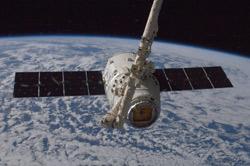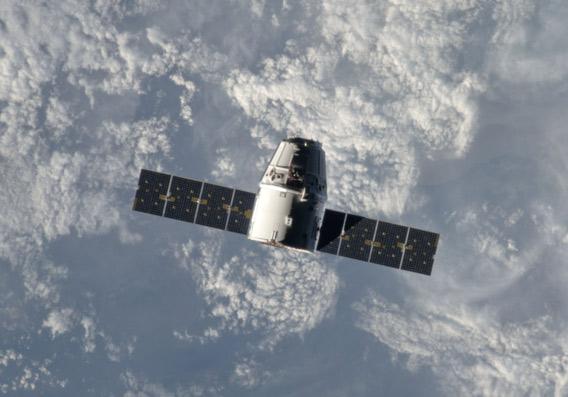A dramatic series of events unfolded this morning shortly after the private commercial company SpaceX launched their Dragon capsule into space. This launch was part of the second of 12 planned missions to bring supplies and equipment to the International Space Station (ISS).
To be clear, things are looking good now, and it looks like the mission will proceed. Just not quite as planned.
Launch, and the Emergence of the Problem
The launch, using the SpaceX Falcon 9 rocket, was essentially flawless. The rocket performed beautifully and was able to cleanly insert the Dragon capsule into the desired orbit.

Image credit: SpaceX
However, shortly thereafter there was a problem. The first indication was that the solar panels—which provide power to the capsule during the mission—did not deploy as they were supposed to, which should happen about 10 minutes into the flight. There is a battery onboard that can provide power for only 12—14 hours, so this was worrisome.
However, news soon came down that the thrusters on the capsule were not working; the tanks containing the oxidizer (used to ignite the fuel) were not pressurizing correctly. The thrusters are small rockets that can be used to change the orbit of Dragon as well as maneuver it on orbit. These are mission-critical: without them, the mission cannot proceed.
Only one thruster pod of the four was working. In general, they need two pods working to do a set of maneuvers before deploying the solar panels. The software onboard sensed this and prevented the panels from deploying. Engineers on the ground noticed that the hardware used to open the panels was getting colder with time, so they decided to send up an override command to deploy the panels. This worked, and about 1 hour 40 minutes after launch, the panels were fully deployed and operational.
At around the same time, they were able to get a second thruster tank to pressurize, which was welcome news. Finally, about five hours after launch, SpaceX CEO Elon Musk announced that the final two thrusters were online and operational. As of this writing, they are still not fully powered up, but are expected to be soon.
So What Happened?
It’s still not entirely clear what happened. During a NASA/SpaceX press conference, Musk noted the oxidizer line (the pipe carrying the chemical) didn’t freeze, but that the oxidizer itself may have frozen, getting stuck and blocking the flow, calling this the “highest likelihood thing” that caused the thruster failure. Other possibilities are debris got caught in the line, or that a valve got stuck.
Frozen oxidizer might actually be (relatively) good news; if true, it’s easily testable and fixable for future flights. With ten more uncrewed flights left in this contract, SpaceX will need to reassure NASA it can fix any problems that occur. It’s not good that this happened, but it could’ve been worse.
I’ll note, too, that this whole drama unfolded in only a few hours from detection to (a hopefully satisfactory) conclusion. Things are very different than they were in the days of Apollo, with a fleet of computer sensors and software uplinks available that help enormously in solving issues like this. Quick thinking and calm heads pulled through here, both on the SpaceX and the NASA side.
What’s Next?

Image credit: NASA/SpaceX
Right now, Dragon is in orbit, powered up, and relatively stable. The first order of business will be changing the orbit a bit. The orbit is elliptical, with the lowest point (called perigee) about 200 kilometers (120 miles) above Earth’s surface. That’s low enough to experience some drag from Earth’s atmosphere, and the capsule could de-orbit after only a day or two if nothing is done. They need to fire the thrusters to raise up the perigee distance and make the orbit more circular. Musk said that can be done with just one thruster, but of course the more the merrier.
As I write this, all systems are green for the orbit circularization. [UPDATE: At 22:16 UTC, Elon Musk tweeted that the burn was successful.]
I expect there will be some time spent thoroughly checking out the system after that. NASA has fairly strict rules about matching orbits with the space station. One thing for sure is that Saturday’s rendezvous is called off; that will have to be postponed until they’re sure everything is copacetic. With the solar panels working, they can keep Dragon on orbit for a month if needed before docking with ISS. [UPDATE (00:50 UTC): Well, that was fast. SpaceX is reporting that Dragon is on its way to the ISS, possibly arriving on Sunday.]
Dragon is loaded with supplies for the astronauts on ISS, but the emphasis on this mission was to bring equipment, as opposed to consumables like air, water, and food (which are generally supplied in bulk by the Russians). There are scientific experiments already in progress on board ISS that can run through September, so there’s no immediate need to get Dragon hooked up.
Phew!
I’m glad this situation is apparently under control. Space travel is not easy, of course. It’s an incredibly complex engineering problem, where a thousand things can go wrong. Most of those are not catastrophic, but as we’ve learned many times, things do go wrong, and in some cases there is catastrophe.
SpaceX has proven to be remarkably resilient in these cases. From their first launches, where delays were frustrating but in some cases quickly turned around into successful missions, to the last Dragon resupply mission where they lost an engine on the Falcon 9 but still got Dragon to orbit (though at the cost of a secondary satellite that didn’t make it to orbit), a lot of quick thinking has allowed progress to be made.
I expect there will be more problems as time goes by, and maybe some big ones. In an operation as ambitious as space exploration, it’s inevitable. My hope is that these will be understood, avoided if possible, and fixed for future missions if not.
And I also hope that others continue to hope. When Challenger was lost, all those years ago, I remember people calling for NASA to be dismantled. That is short-sighted, reckless, and just plain wrong. The technical challenges of getting into space are daunting, but they are also something we can and must do.
Ships are safe in the harbor, but that’s not what ships are for.
My congratulations to SpaceX and NASA for their work on this, and hopefully they will get this mission back underway as quickly as possible.
